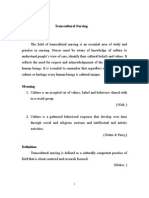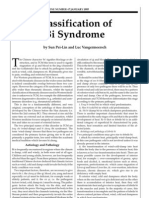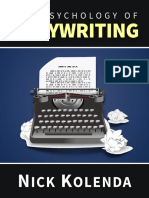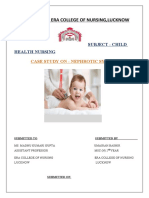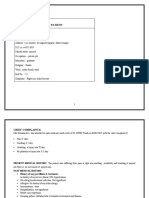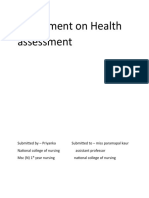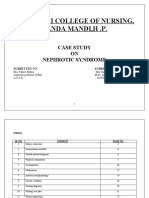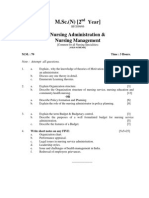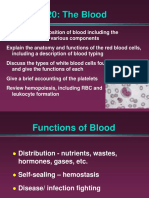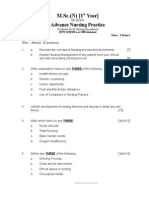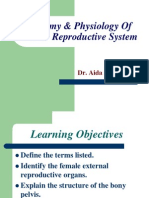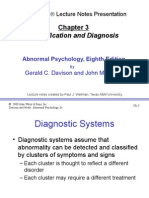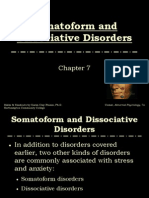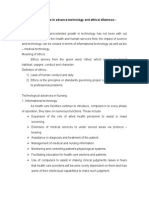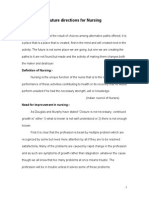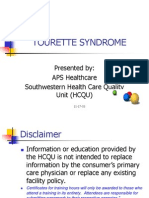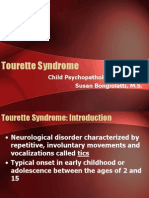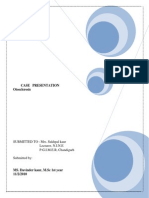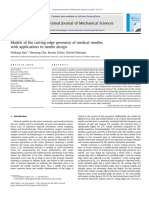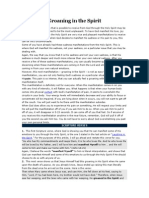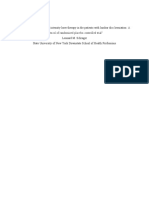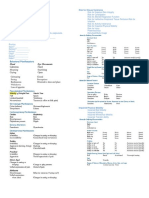0 ratings0% found this document useful (0 votes)
906 viewsLees Burn
Lees Burn
Uploaded by
Jennifer DixonThis document contains identification and medical history information for a 3-year-old male patient admitted to the burn step down ICU with a diagnosis of second degree burns on his thighs and gluteal region. It provides details of his family history, physical exam, nursing diagnoses, and short and long term treatment goals. The cause of his burns was from falling into a hot water bucket while playing.
Copyright:
© All Rights Reserved
Available Formats
Download as DOCX, PDF, TXT or read online from Scribd
Lees Burn
Lees Burn
Uploaded by
Jennifer Dixon0 ratings0% found this document useful (0 votes)
906 views20 pagesThis document contains identification and medical history information for a 3-year-old male patient admitted to the burn step down ICU with a diagnosis of second degree burns on his thighs and gluteal region. It provides details of his family history, physical exam, nursing diagnoses, and short and long term treatment goals. The cause of his burns was from falling into a hot water bucket while playing.
Original Description:
burn
Original Title
lees burn
Copyright
© © All Rights Reserved
Available Formats
DOCX, PDF, TXT or read online from Scribd
Share this document
Did you find this document useful?
Is this content inappropriate?
This document contains identification and medical history information for a 3-year-old male patient admitted to the burn step down ICU with a diagnosis of second degree burns on his thighs and gluteal region. It provides details of his family history, physical exam, nursing diagnoses, and short and long term treatment goals. The cause of his burns was from falling into a hot water bucket while playing.
Copyright:
© All Rights Reserved
Available Formats
Download as DOCX, PDF, TXT or read online from Scribd
Download as docx, pdf, or txt
0 ratings0% found this document useful (0 votes)
906 views20 pagesLees Burn
Lees Burn
Uploaded by
Jennifer DixonThis document contains identification and medical history information for a 3-year-old male patient admitted to the burn step down ICU with a diagnosis of second degree burns on his thighs and gluteal region. It provides details of his family history, physical exam, nursing diagnoses, and short and long term treatment goals. The cause of his burns was from falling into a hot water bucket while playing.
Copyright:
© All Rights Reserved
Available Formats
Download as DOCX, PDF, TXT or read online from Scribd
Download as docx, pdf, or txt
You are on page 1of 20
IDENTIFICATION DATA:
Name : Deema Nath
Age : 3 yrs
Sex : Male
C.R no : 587973
Bed no/ Ward : 17/Burn Step Down ICU
Religion : Sikh
Nationality : Indian
Date of admission : 01/01/11
Diagnosis : II Degree Burn
Consultant : Dr.R.K.Sharma
Fathers education : Class XII
Fathers occupation : Business
Mothers education : Matriculate
Mothers occupation : House wife
Address : Ludhiana
Informant : Mother
CHIEF COMPLAINTS
Scald burn on 1.01.2011
HISTORY OF PRESENT ILLNESS
Child was apparently normal before burn accident injury. He got burn when he playing fell into
hot water bucket on 1.01.2011 at 9am. The child was taken to a local hospital where the child
received burns emergency treatment. Then child was referred for further treatment in
PGIMER Chandigarh. Child was admitted on 1.01.2011 in Emergency where he was diagnosed
as a case of II Degree Burn on thighs and gluteal region and is undergoing treatment.
HISTORY OF PAST ILLNESS:
No h/o any significant illness in the past.
PERSONAL HISTORY
Antenatal History: Antenatal period was uneventful and the mother had undergone regular
antenatal checkups.
Birth History: The first child of a primigravida, born at term vaginally at a private nursing home.
According to the mother, child cried immediately after birth.
Developmental History: appropriate for age. No delay in any milestone. Child runs around and
climb stairs, rides bicycle and undress by his own. He names some common objects and use
small sentences.
Immunization History: Child is immunized appropriate to age. He has received BCG at birth,
three doses of Hep B, DPT and OPV and one MMR, measles and DT.
FAMILY HISTORY:
The child resides in a nuclear family with a total of 4 members
FAMILY TREE:
SOCIO-ECONOMIC STATUSA Middle class family with adequate sanitation facilities. They have a
separate kitchen and bathroom. They have access for safe drinking
GENERAL PHYSICAL EXAMINATION
Body built :Thin build
Gait :Normal
Height :70 cm
Weight :15 kg
Pulse :140/min
RR :24/min
Congenital malformations: absent
Father,
31yrs
Mother
30yrs
3yrs
1yr
HEAD TO FOOT ASSESSMENT:
Head shape :Normal head size and shape, no hydrocephalus.
Eyes :Pupils normal size, reacting to light, normal eye color.
Lips :Pink, no cracked lips.
Nose :Normal, no abnormal discharge, no DNS
Ear :Normal hearing, no discharge, wax or pus formation.
Tongue :Pink, moist.
Teeth : Normal
Neck :Normal length, no palpable lymph nodes.
Chest :Normal chest movements, no wheezing, nipples are normal and there is
no discharge from the nipple.
Abdomen :Bowel sounds present, no abdominal distension.
Back :Normal curvature of spine.
Extremities : Upper extremities normal movement. Pain in the lower extremities due
to burn around both thigh.
Genitalia :Bilateral testis normal, urinary meatus normal, no abnormal urethral
discharge or pain during micturition.
SYSTEMIC EXAMINATION:
Respiratory system:-
RR:28/min
Normal respiration
Bilateral chest clear, air entry equal.
Cardiovascular system:-
HR: 140bpm
S
1,
S
2
normal
CFT:2 sec.
All peripheral pulses are palpable.
Central Nervous system:-
No History of seizures.
Normal Reflexes
Both pupils are normal size and reacting to light.
GCS is E
4
V
5
M
6
Musculoskeletal system: -
All joints are normal, no inflammation in upper extremities. Pain in lower extremities and
inflammation around thigh due to burns.
Endocrinal system:-
No endocrinal dysfunction is yet noticed, No disease related to endocrine system is present.
Gastrointestinal system:-
Bowel sounds are present
Taking orally and tolerating foods well.
Genitourinary system:-
Bilateral testis normal.
Foleys catheterization, No hematuria, urinary tract infection
Integumentary system:-
Hydration poor, normal colour and texture of skin except burn area
NURSING DIAGNOSES:-
Pain related tissue and muscle injury due burn.
Risk for infection related to altered skin integrity, immobility and altered immune
response
Decreased cardiac output related to fluid loss and fluid shifts
Ineffective tissue perfusion related to peripheral edema and circumferential burns
Impaired physical mobility related to edema, pain,
Altered nutrition less than body requirements related to hyper metabolic response to
burn injury and poor appetite
Ineffective coping related to fear and anxiety
Disturbed body image related to cosmetic and functional sequelae of burn wound
Altered parenting related to crisis situation, prolonged hospitalisation and promote
healing.
SHORT TERM GOAL:
Minimize or control the pain.
Infection control
Minimization of patients and familys anxiety
Maintenance of adequate tissue perfusion
Restoration of optimal fluid and electrolyte balance and perfusion of vital organs
LONG TERM GOAL:
To educate the parents about the nature of the disease, its course, treatment regimen
and prognosis.
To maintain hygiene at home.
To teach the parents about burn diet.
DISEASE IN DETAIL
BURNS
Introduction:- Burns are common and serious childhood injury causing prolonged effect on
growing child with complications and fatal diagnosis. The exact data about incidence of burn
injury is not available. Children are at higher risk of burn injury than adults. Approximately
about one fourth of burns are below 10 yrs of age and 65 % are below 5yrs of age. Over 80% of
burns accidents occurs in the childs own home. Scalds from hot liquids constitute maximum
numbers & others are due to flame burns, electrical or chemical burns. Most burns are
relatively minor and do not require definite medical treatment, however, burns involving a
large body surface area, critical body parts, or geriatric or pediatric population often benefit
from treatment in specialized burns centers.
DEFINITION
Burns are the tissue injury caused by the contact with heat, flame, chemicals, electricity and
radiation. The effects of burn injury are not limited to the burn area but can cause serious
systemic damage effects depending upon extent and depths of the burns.
EPIDEMIOLOGY AND ETIOLOGY
Various causes of burn injuries can be classified as follows:
1. Thermal Burns
Flame due to dry heat
Scalds- due to moist heat
Contacts
2. Inhalation Injuries
Airway injuries
Lung injuries
Systemic intoxication
3. Electrical burn due to high voltage electrical contact
4. Chemical burns due to chemicals like
Acid
Alkali
Organic hydrocarbons
5. Cold injury
Freezing cold injury
Non freezing cold injury
6. Radiation burns
7. Child abuse is another aspect of burns injury. Evidence of previous abuse, symmetrical
injuries, multiplicity of injuries, burns to back of hands, single parent and poor socio
economic status point towards child abuse.
8. Higher incidence are seen in winter because of :-
Increased indoor activities
Increased consumption of hot drinks
Use of hot water for bath
Use of fire for warm
Festivities and marriages with use of lighting and fire crackers in winter seasons.
PATHOPHYSIOLOGY
A burn injury represents a catastrophic insult that involves all organ systems. An understanding
of the pathophysiology underlying thermal trauma is essential to provide appropriate nursing
care.
I. LOCAL SKIN RESPONSE: Damage to human skin by heat results in two types of injury, an
immediate direct cellular response and a delayed cellular response due to dermal
ischemia. Irreversible cellular damage from protein denaturation occurs at
temperatures exceeding 45.c (113.F). Three zones of tissue injury have been identified
as follows:-
a) Zone of coagulation is the zone of contact of heat or the innermost area of burn, cellular
death caused by thermal trauma is an irreversible process that results in full thickness
tissue destruction. The appearance of the skin is white or gray with no blanching. This
area will increase in size, depending upon the heat intensity and duration of exposure.(
irreversible tissue loss due to coagulative necrosis)
b) Zone of stasis: is a zone of cellular damage due to temporary lack of adequate supply.
Vasoconstriction occurs, leading to sludging of blood cells and an increase in tissue
edema. The appearance of the red skin is red with no blanching. This area of deep
partial thickness injury is very fragile & further trauma or infection may lead to necrosis
and extension of the depth of injury.( Tissue is viable but can deteriorate to necrosis if
not adequate resuscitation)
c) Zone of hyperemia: is farthest away from the insult and is the area least affected by the
heat. Vascularity is maintained and no cellular death occurs. The skin is red & blanching
with pressure.( outermost zone with increased tissue perfusion. Tissue usually recovers
in absence of severe infection or severe tissue hypo perfusion)
Intravascular Volume: The intravascular volume is depleted in all burns, its extent being the
greatest in burns involving the dermis. The loss of plasma takes place from the site of burns and
rest of the circulatory system
Burn Edema: Endothelial destruction in the region of burns permits exudation of plasma from
the intravascular space. The microcirculation is likely to be affected by release of locally
released mediators like histamine, prostaglandin, thromboxane A2 & oxygen radicals.
Non Burn Edema: Hypoproteinemia has been implicated as the main cause of edema distant
from the site of burn.
The combination of burn & non burn edema can be dangerous around the neck and
head where it can cause swelling of face, tongue and supraglottic structure. The edema reaches
its peak at 24-36 hrs & early intervention is required to secure airway while it is still possible.
2. SYSTEMIC RESPONSES:
CARDIOVASCULAR SYSTEM: the immediate post burn period is marked by dramatic
alterations in circulation, known as burn shock. There is drop in cardiac output
attributed to a circulating myocardial depressant factor that is associated with severe
burn injury & directly affects the contractility of the heart muscle. As a result of fluid
loss through denuded skin, increased capillary permeability & vasoconstriction, the
cardiac volume decreases rapidly, cardiac output is reduced further. Following fluid
resuscitation, cardiac returns to normal in 24-36 hrs, if fluid is not replaced; cardiac
output is continuously decreased, resulting in inadequate perfusion, organ dysfunction
& ultimately death.
Capillary permeability with leakage of fluid takes place both in uninjured areas& in burn
wound. Together with the shrinkage of drying eschar, severe edema due to rapid fluid
shift to the interstitial spaces may produce the tourniquet effect, resulting in
Compartment Syndrome. Treatment is required during acute phase consisting of
escharotomy (surgical excision of the burned tissue), if not sufficient then incision of
muscle or fasciotomy is performed. In most children, the CVS, is able to withstand the
demands placed on it, although shock is prominent feature in thermal injuries. Some are
prone to congestive heart failure & pulmonary edema.
RENAL SYSTEM: loss of fluid from the intravascular compartment causes renal
vasoconstriction that in turn leads to reduced renal plasma flow & depressed glomerular
filtration. When adequate fluids are provided, the glomerular filtration rate returns to
normal, and by the third or fourth post burn day, urinary output increases as edema
fluid is mobilized and eliminated. Oliguria in first few days is more of inadequate fluid
replacement than of acute renal failure.BUN & creatinine are elevated because of tissue
breakdown, decreased circulating volume and oliguria. Hematuria may be evidenced
from hemolysis of RBCs,and oliguria of increased pigment load. Myoglobinuria is
especially common following extensive electrical injury. Cell destruction release large
amount of myoglobin which occludes the kidney tubules and place the victim trauma at
risk for renal failure.
Renal response in infants younger than one year old differs, as fluids are retained
because of an immature renal system and output diminishes as fluid resuscitation
increases. This retention may be present for several weeks although the evaporative
water loss may balance excessive retention.
GASTROINTESTINAL SYSTEM: Perfusion of the GI tract and liver are decreased as a result
of changes in blood flow. Ischemia of the GI tract has been found to initiate and
aggravate erosion and necrosis. Gastric acid production is initially suppressed for 43-72
hrs after injury and then surpasses normal levels. Catecholemines may be a factor in the
suppression. Increase acid production and autolysis of pepsin significantly increase the
risk of erosion and ulceration. Following major burn injury, gastric ileus may occur, the
stomach dilates with digestion virtually ceasing, ileus of the large intestine may also
occurs but small intestine usually maintains mobility and absorptive capacity.with GI
intact, enteral feedings with nasogastric tube are begun immediately after acute
resuscitation.
METABOLISM: the greatly accelerated metabolic rate in burn patients is because the
child has limited glycogen stores to provide energy, which therefore accelerates the
protein and lipid breakdown. No other disease state produces as great a
hypermetabolism as the burn injury. Therefore the child is vulnerable to prolonged
starvation. When the burn injury is extensive, energy may approach twice the predicted
basal metabolic requirements.
The stress of injury places high demands on the body. Stress invoked glycogen
breakdown depletes the energy stores in 12 to 24 hours after which the body resorts to
glycogenesis for high-energy needs. Blood glucose levels may be elevated as a results of
insulin resistance. Rapid protein breakdown and muscle wasting occur if sufficient
protein is not provided.
As a result of accelerated metabolism, children with burn injuries exhibit an
elevated body temperature, even in absence of infection. Heat is loss as a result of the
energy consuming process of water evaporation from the damaged skin surface. Each
millimeter of water evaporated uses 0.58 cal of heat energy. Infant & children are
especially vulnerable to metabolically active tissue. Burning destroy a lipid layer and
converts skin that is normally impermeable to water to a state that transmits water
vapour at least four times as rapidly as unburned skin. Evaporative losses continue until
partial thickness wounds are healed. Temperature regulating centre under 6 months of
age is immature and is maintained by non shivering thermogenic metabolic
process,therefore higher room temperature is needed to decrease the evaporative loss.
IMMUNE RESPONSE: Systemic immune responses are affected in severe burns.
Immunoglobulins such as IgA, IgM, and IgG all are all immediately depressed in children
after an injury but then rise slowly, most defense mechanism are depleted, making
them vulnerable to bacterial infection at the site of the injury.
GROWTH AND DEVELOPMENT: Children may demonstrate post burn growth
retardation. Severe growth delays in height and weight have been shown in children
who sustained a greater than 40% TSBA burn.
PULMONARY SYSTEM: The impact of thermal injury on pulmonary function includes a
full range of respiratory dysfunctions, including inhalation injury, aspiration of gastric
contents, bacterial pneumonia, pulmonary edema and insufficiency and emboli.
Pulmonary complication remains the leading cause of death following thermal injury.
WOUND SEPSIS: wound sepsis is a critical problem in the treatment of burns and is an
ever present shock phase.
CENTRAL NERVOUS SYSTEM: Encephalophathy in the burn patient is a relatively
common occurrence. The manifestations of encephalopathy include hallucinations,
personality changes, delirium, seizure and coma. Postburn seizure appear to be unique
to the pediatric patient.
Assessment of Burn Injury
The burn wound has to be evaluated for:
Its extent in relation to the total body surface area
For the depth of skin burnt
To establish criteria for admission
To classify the wounds as minor, moderate or critical for the purpose of
management
For calculating the initial fluid requirements during resuscitation
To enable the surgeon to answer prognosis-related queries from the parents, eg
with regard to survival, expected time of healing, need for surgical intervention,
rehabilitation, scarring etc.
CLASSIFICATION OF BURNS
According To the depth of injury:
1. Superficial or first degree burn: The tissue damage is minimal, the protective functions of
the skin remains intact,systemic effects are rare. Pain is predominant symptom and
wound heals in 3 to 6 days eg mild sunburn.
2. Partial thickness or second degree burn: involves the epidermis and varying degree of the
dermis, these burns are painful, moist, red and blistered. Superficial partial thickness
burns involves the epidermis and part of the dermis. Dermal elements are intact, & the
wounds heals approximately in 14 days without scars. Deep dermal burn although
classified as second degree or partial thickness burns, the wound is extremely sensitive to
temperature change, air and light touch. Sweat gland and hair follicles remain intact. The
burn may appear mottled with pink, red or waxy white areas exhibiting blisters and
edema formation. The wound heals spontaneously within 30 days, and extensively with
scar.
3. Full thickness or third degree burns are serious injuries involve the entire epidermis and
dermis and extend to subcutaneous tissue. Thrombosed vessels can be seen beneath the
surface of the wound and nerve endings, sweat glands and hair follicles remain intact. The
burn varies in colours from red to tan, waxy white, brown or black and a dry , leathery
appearance. Normally full thickness lack sensation in the area of injury because of the
destruction of the nerve endings. However most full thickness have superficial and partial
thickness burned area at the periphery of the burn where nerve endings are intact &
exposed, also excised eschar and donor site causes exposed nerve fibre, finally as
peripheral fibre regenerate, sensation of pain returns. Full thickness burn are not capable
of reepithelialization & require surgical excision and grafting close to the wound.
4. Fourth degree burn: are also full thickness injuries involving the structures such as
muscles, fascia and bone. Wound appear dull and dry , ligaments, tendons and bone may
be exposed.
According to severity of injury:
1. Minor injuries that are able to treat as out patient basis. i.e. first degree burn, second
degree burn less than 10% of body surface or third degree burn less than 2% of body
surface & no area of face, feet, hand or genitalia is involved.
2. Moderate burn who may be treated in hospital with expertise in burn care i.e. second
degree burns of 10-20% , burns on area of face, feet, hand or genitalia is involved, or third
degree burns less than 10% or smoke inhalation
3. Major burn injury those requiring the service and facilities of a specialized burn centre. i.e.
second degree burns more than 20% or third degree burns of more than 10% body
surface area.
According to the extent of injury:
The extent of injury is expressed as a percentage of total body surface area (TSBA) injured.
The child has different body proportions than adult, resulting in inaccurate estimation of
injury if the standard adult rule of nine is used. The proportion of the childs trunk and arms
are roughly the same as the adult however the head & neck are make up of 18% of the TSBA
and each lower extremity for 14% of TSBA. As the child grows percentage are deducted from
the head and assigned to the legs. A modified rule of nines prop any chart ose that for each
year of life after 2years, 1% is deducted from the head and 0.5% is added to each leg. It is
generally more efficient to use any of the charts designed.
ESTIMATION OF EXTENT OF BURNS SURFACE AREA
Various methods used to calculate the burnt area.
1. The easiest way is to use the rule of hand. One surface (childs own hand) with closed
fingers, amounts to 1% of body surface area & can be used for calculation the extent
of burn
2. The quick & easiest way is to use the rule of five(lynch and blocker)
3. The most accurate can be done using the Lund and Browder chart, which gives the
exact percentage at different age groups in different parts of the body.
4. The rule of nine is applicable for children above 10 yrs.
Pediatric Body Surface Area Calculation
.
CLINICAL MANIFESTATIONS
The clinical features are manifested depending upon the degree of burns. There may be:-
Symptoms of shock like pallor, cyanosis, prostration, poor muscle tone (may appear
flaccid) and failure to recognized familiar people, rapid pulse, low BP, and sub normal
temperature.
Inhalation injury causes inflammation of edema of the glottis, vocal cords and upper
trachea leading to upper airway obstruction. There is usually dyspnea, tachypnea,
hoarseness, stridor, chest retractions, nose flaring, restlessness, cough and drooling.
Smoke inhalation initially may produce no symptoms or mild bronchial obstruction but
suddenly within 48hrs may develop pulmonary edema, severe airway obstruction and
bronchiolitis
Symptoms of toxemia may develop after one or two days. The patient usually manifested
fever, vomiting, edema, decreased urine output, prostration, rapid pulse, glycosuria and
unconsciousness.
Clinical Manifestation in Patient: Burn in both thighs and gluteal region,pain.
ASSESSMENT
A thorough history should be obtained shortly after admission to enable nurse to plan for
supportive, age appropriate management. History of incident, acute and chronic
conditions, past hospitalization, immunization, allergy, developmental history etc and try
to eliminate child abuse.
Other area of assessment include;-
The size of the burn/extent of burn injury, determine by using the Lund & Browder chart
in children
Depth of injury to identify if it is first, second, third or fourth degree burn and types of
burn eg scald.
Age of the patient-mortality due to burn injury increase in children younger than 2yrs.
Past medical history- because pre-existing illness complicates the burn therapy.
Location of the burn injury eg burn of the head, neck, chest increase the incidence of
pulmonary complications, burns of the hands, face or feet can lead to functional or
cosmetics alteration. Joint involvement can lead to loss of mobility.
Associated trauma which can also complicate the burn.
DIAGNOSTIC EVALUATION
Laboratory values of urine for specific gravity & hemochromogens are monitored
Laboratory values of blood for complete blood count, BUN, serum protein,
serum albumin,blobulin,immunoglobulins &ABGs.
Xrays for history of smoke inhalation or trauma.
Investigations done in patient
Name of the
investigation
Normal values Patient s findings
1.1.11 3.1.11 12.1.11
Hb 12-18 g/dl 6.5g/dl 9.6g/dl 12.2g/dl
Platelet 150 400 x 10
3
155x10
3
155x10
3
155x10
3
TLC 4-11 x 10
3
15,540 22200 24400
DLC neutrophil 40-75% 50% 54% 56%
Lymphocyte 20-45% 30% 32% 34%
Monocyte 2-10% 3% 4% 5%
Eosionophil 1-6% 3% 3% 4%
Blood urea 10-50 mg/dl 18 mg/dl 10 mg/dl 30 mg/dl
Serum creatine 0.5-1.2 mg/dl 0.2 mg/dl 0.2 mg/dl 0.2 mg/dl
Sodium 135-149 meq/lt 130meq/lt 140meq/lt 144meq/lt
Potassium 3.5-5 meq/lt 3.8 meq/lt 4.0 meq/lt 5.6 meq/lt
Chloride 90-108mm0l/lt 95mmol/lt 103mmol/lt 101mmol/lt
First Aid
At scene as soon as possible extinguish flames, skin temp to normal
Damage d/t heat temp of burning agent, duration of contact
Tap water readily available, chance of hypothermia less than with ice/ cold water
Chemical burns prolonged washing (1/2-1 hr) with copious water
No household remedy/ topical agent be applied evaluation of depth difficult, removal
painful
Cover clean sheet prevent contamination/ hypothermia transport to medical
facility at earliest
NPO prevent vomiting
Before transport to burn center:
Establish patent airway 100% humidified Oxygen.
Adequate peripheral circulation is established in any burned extremity.
A secure IV catheter is inserted
Ringer lactated's solution infusing at the rate required to maintain a urine output of at
least 30 mL per hour.
Indwelling urinary catheter
Administer IV pain medication (Morphine)
Wounds are covered with a clean, dry sheet
Keep patient comfortably warm
Burn Phases:
Emergent / Resuscitative Phase
First 24-48 hrs
Fluid loss through open wound or extravasation into deeper tissues
Hypovolemia
Renal complications possible
Hyperkalemia
Pulse, Blood Pressure
Intermediate / Acute Phase
Begins 36-48 hrs after burn
Decrease in peripheral edema
Blood volume restored
Diuresis if renal system is unimpaired
Hypokalemia
Blood pressure
Interdisciplinary Care
Emergent / resuscitative stage
Emergency team (EMT, ED)
Acute stage
Burn team (ICU), Nutrition, Wound, Rehab, Psychosocial support
Rehabilitative stage
Social service team, Rehab, Community services
Management of Fluid Loss Emergent stage
Fluid resuscitation formula
Lactated Ringers, plasma
Adequate replacement if:
Urine output to be 30 ml 50 ml / hr
Systolic B/P > 100 mg Hg
Pulse < 110
Hourly strict Intake and Output
Clinical parameters important indicators of effectiveness of fluid resuscitation
WOUND TREATMENT
Surgical debridement
Fasciectomy
Escharotomy
Autografting
Allograft
Xenograft
WOUND MANAGEMENT
Avoid
Cross-contamination of wounds
Wrapping dressings too tightly around extremity
Use
Topicals
Reduce the number of bacteria only
Silver sulfadiazine (Silvadene)
Slow release dressings such as Acticoat, Aquacel, Silversorb, Silverlon
Without topical antimicrobial agents the wound becomes colonized with gram pos
organisms within 48hrs.most common gram pos : beta hemolytic streptococcus and
staphylococcus.
Gram negative organisms appear after 3-21days. Pseudomonas , proteus and
acinetobacter baumani are the most common organisms
Eschar will become infected unless its removed by re - epithealization process or
surgical excision
Systemic antibiotics only if systemic infection.
Showering better than bathing- less wound cross contamination
Dressing wound must be done under sterile conditions
Blister removal controversial-recommendation is to aspirate blister and leave skin intact
Wound swab useful to dx bacteria but cant differentiate between colonisation and
wound infection, tissue culture is superior (quantifies bacteria)
PCT, CRP, WCC, NEUTROPHILS ,TEMP useful markers to monitor sepsis
Delayed burn surgery associated with increased infection
Superficial and small burns heal within 2 weeks
Large deep dermal burns heal within 2-3 weeks
Any burn not healed after 3weeks needs grafting
Open dressings: inexpensive but increased heat and fluid loss , though decrease
incidence of pseudomonas
Closed dressings :reduce heat and moisture loss, less painful, but higher incidence of
pseudomonas
TREATMENT IN THE PATIENT
Surgical Debridement/Escharotomy plus STSG was done on 12.1.11
Inj Ceftriaxone 600mg IV BD
Inj Amikacin 180mg OD
Syp Ibugesic 6ml 8hrly
1 unit of Whole blood given intra operative
NURSING MANAGEMENT
THREE PHASES OF BURN CARE;-
1. Emergent Burn Care: at the time of injury till condition stabilized -48-72hrs. Nursing
management includes:-
a. Initiating emergency resuscitation along with the physician and secondary nurse as a
team, also establishing airway, fluid therapy, stabilizing fracture, initiate gastric
decompression, inserting Foleys catheter, obtaining baseline diagnosis studies,
wound evaluation and management.
b. Orienting family members
c. Initiate prescribed therapies ie the physicians orders and management
d. Monitoring physiologic responses ie pulmonary status, hydration status, GI status,
neurological assessment
e. Initiating measure to prevent complications
f. Providing emotional support
2. ACUTE BURN CARE begins with stabilization at approximately 48-72hrs till wound
healing is complete. Nursing management includes:;
a. Managing burn wound ie dressing changes
b. Providing pain relief by pharmacologic and non pharmacologic pain control method
c. Providing nutritional support
d. Monitoring for complication
e. Providing emotional support
3. REHABILITATION AND DISCHARGE
a. Rehabilitative burn care
b. Providing skin care and wound management
c. Providing physical program
d. Providing scar management
e. Providing for social re-entry
COMPLICATIONS
EARLY COMPLICATIONS- Hypovolemic shock, respiratory failure, paralytic ileus, GI bleeding
due to curlings ulcer, wound sepsis, thrombophlebitis, urinary tract infections, hypostatic
pneumonia, toxic shock syndrome, post burn seizures, hypertension, depression, etc.
LATE COMPLICATIONS- Anemia, malnutrition, growth, Marjolins ulcer (carcinoma in burn
scar), contracture, psychological trauma and cosmetic problems.
PREVENTION
Never carry hot liquid and/or food near your little one. You may have never spilled a
cup of coffee before, but the very time you decide to carry your little one while you are
carrying something hot, that may be the first time you spill it. Therefore, it is better to
be safe than sorry.
Put a safety lock on your stove. Safety stove locks prevent little ones from turning the
burners or oven on. You can also remove the knobs off of the stove. However, stove
locks may look better.
Always use the back burners on a stove when cooking. Also, don't forget to turn the pot
handles toward the back of the stove.
Use electrical outlet covers. Little ones love sticking objects into holes.
Make sure your smoke detector is working. They should be on every floor of your
home. Place them up high and near the kitchen and bedrooms. Make sure to check your
smoke detector monthly to make sure they are working properly. And if you need one,
you may be able to get one for free at your local fire department.
Set up a fire escape plan. Get your little ones involved. Talk to them about what to do in
the event of a fire.
Never leave matches, lighters, or flammable objects in the reach of children.
Do not use portable heaters around children. A little one will want to touch it or stick
something in it.
Use a cool-mist humidifier instead of a hot steam one.
Teach your little one about the word "HOT". You can do this by letting your little one
touch the outside of a WARM coffee cup.
Never leave a little one alone in the kitchen and bathroom.
REFERENCES:
Kliengman and et al; Nelson Textbook of Pediatrics; 18
th
edition; vol.1;
OP Ghai and et al; Ghai Essential Pediatrics; 7
th
Edition; 647-648
Isselbacher et al; Harrisons Principles of Internal Medicine7th Edition ;247-254.
Donna L Wong; Essentials of Pediatric Nursing; 5
th
edition; Pages;793-811.
Hockenberry et al. Wongs Nursing Care of Infants and Children. 7
th
Edition. Pages;1253-
1281.
Lipponcot Mannual of nursing Practice 8
th
edition;pages:1689-1691.
Behrman.E.Richard. Textbook of Pediatrics. 1
st
Indian edition 76-77
Datta. Parul.Pediatric Nursing.371-376.
Gupte Suraj. Text book of Pediatric Emergencies. 1
st
edition.468-474
www.google .com
www.pubmed.
Case Presentation on
BURN
SUBMITTED TO: Dr. (Mrs.) Sukhwinder Kaur
Lecturer, NINE PGIMER
Chandigarh
SUBMITTED BY: Gopal Singh Charan
M. Sc. N. II Year (Pediatric)
NINE PGIMER, Chandigarh
You might also like
- Transcultural NursingDocument14 pagesTranscultural NursingJennifer Dixon100% (1)
- Iggy Med Surg Test Bank Chapter 005Document19 pagesIggy Med Surg Test Bank Chapter 005Tracy Bartell80% (10)
- Classification of Bi SyndromeDocument7 pagesClassification of Bi Syndromecharrie7100% (1)
- Observation Report CCU: Era University Era College of Nursing LucknowDocument7 pagesObservation Report CCU: Era University Era College of Nursing Lucknowarchana vermaNo ratings yet
- College of Nursing: Assignment ON Nursing ClinicDocument5 pagesCollege of Nursing: Assignment ON Nursing ClinicPriyaNo ratings yet
- Pain 5th Vital SignDocument23 pagesPain 5th Vital SignMohammed Heriza100% (1)
- Case Analysis March 11Document5 pagesCase Analysis March 11Nicole Villanueva, BSN - Level 3ANo ratings yet
- MidtermDocument22 pagesMidtermEmvie Loyd Pagunsan-Itable100% (1)
- The Science of CopywritingDocument40 pagesThe Science of CopywritingRolffoTelloNo ratings yet
- Case Study: "Burn Injury"Document24 pagesCase Study: "Burn Injury"ChAtmaRosE100% (1)
- Care Plan On ARTHROPLASTYDocument19 pagesCare Plan On ARTHROPLASTYPreeti ChouhanNo ratings yet
- Case Study of Head Injury SijiDocument30 pagesCase Study of Head Injury SijiJinal PatelNo ratings yet
- Meddical Care Study Part 1Document48 pagesMeddical Care Study Part 1christyNo ratings yet
- NURSING Care Plan On MiDocument20 pagesNURSING Care Plan On MiSanvar Mal Soni100% (1)
- CASE STUDY ON CholelithiasisDocument20 pagesCASE STUDY ON CholelithiasisSimran ChauhanNo ratings yet
- Nursing Care Plan On Day - 1: Identification DataDocument26 pagesNursing Care Plan On Day - 1: Identification DataManisa ParidaNo ratings yet
- Drug StudyDocument10 pagesDrug StudyBandana RajpootNo ratings yet
- Case Presentation Meningitis 1Document17 pagesCase Presentation Meningitis 1chaudharitrushar007No ratings yet
- Broncho Pnuemonia MEDICALDocument9 pagesBroncho Pnuemonia MEDICALArchana SahuNo ratings yet
- Varicose VainsDocument28 pagesVaricose Vainssingireddi1revathi100% (1)
- Clinical Presentation On AppendicectomyDocument30 pagesClinical Presentation On AppendicectomyValarmathi100% (1)
- Bronchial Asthma Careplan BBDocument26 pagesBronchial Asthma Careplan BBKshayna 12340% (1)
- Case Study On BronchitisDocument19 pagesCase Study On BronchitisSuchitaNo ratings yet
- Case Study On Jaundice-1Document30 pagesCase Study On Jaundice-1kamini ChoudharyNo ratings yet
- JG College of Nursing: Sub: Medical-Surgical NursingDocument33 pagesJG College of Nursing: Sub: Medical-Surgical NursingmilcahNo ratings yet
- Care Plan ON PEM: Maa Tripura College of Nursing, Jhabua (M.P.)Document7 pagesCare Plan ON PEM: Maa Tripura College of Nursing, Jhabua (M.P.)amit100% (1)
- Case Study On Nephrotic SyndromeDocument7 pagesCase Study On Nephrotic SyndromeArchana VermaNo ratings yet
- BronchitisDocument24 pagesBronchitismeghana67% (3)
- Case Presentation On GbsDocument23 pagesCase Presentation On GbsRucHi ShArmaNo ratings yet
- Tuberculosis Care Plan SoniDocument23 pagesTuberculosis Care Plan SoniSanvar Mal Soni100% (2)
- Nursing Careplan For TofDocument17 pagesNursing Careplan For Tofanamika sharmaNo ratings yet
- Identification DataDocument22 pagesIdentification DataDimpal Choudhary100% (1)
- CP On AnginaDocument21 pagesCP On AnginaNavpreet Kaur100% (1)
- Health Assessment of Ent MSNDocument11 pagesHealth Assessment of Ent MSNJaseel Muhammed BNo ratings yet
- Case Study On Angina PectorisDocument4 pagesCase Study On Angina Pectorismahi0% (1)
- Care Plan-OtitisDocument33 pagesCare Plan-OtitisSunil KumarNo ratings yet
- Assignment On Health Assessment 1Document5 pagesAssignment On Health Assessment 1Sumit YadavNo ratings yet
- NCP HydrocephalusDocument10 pagesNCP HydrocephalusHardeep Akku100% (2)
- Case Presentation On CVTDocument32 pagesCase Presentation On CVTraman kumari100% (1)
- Nursing Care PlanDocument14 pagesNursing Care Plananimesh panda100% (3)
- Case Study On Meninomyocele (Repaired) PDocument29 pagesCase Study On Meninomyocele (Repaired) Pcharanjit kaur100% (1)
- COPDDocument22 pagesCOPDOM BAWNENo ratings yet
- PICU Case StudyDocument27 pagesPICU Case Studyjyoti singhNo ratings yet
- Case Presentation 1 CopdDocument48 pagesCase Presentation 1 CopdPreeti ChouhanNo ratings yet
- MICRO TEACHING Physical Examination of ChildrenDocument5 pagesMICRO TEACHING Physical Examination of ChildrenBini Don DanielNo ratings yet
- CASE Presentation2Document22 pagesCASE Presentation2Kavita Guleria100% (2)
- Health Assessment Peptic UlcerDocument13 pagesHealth Assessment Peptic UlcerHimani PatelNo ratings yet
- Case Study On Cleft Lip, Cleft PalateDocument25 pagesCase Study On Cleft Lip, Cleft Palatebiswaspritha.18No ratings yet
- Case Presentation On Myocardial InfarctionDocument27 pagesCase Presentation On Myocardial InfarctionAmit RanjanNo ratings yet
- Care Plan On: Submitted To: Submitted byDocument38 pagesCare Plan On: Submitted To: Submitted byMoonNo ratings yet
- Case Study 1 AnginaDocument27 pagesCase Study 1 AnginaSantosh ChoudharyNo ratings yet
- Care Plan On CataractDocument36 pagesCare Plan On CataractPATEL NEHAKUMARI VIMALBHAINo ratings yet
- DENGUEDocument43 pagesDENGUESachin solankiNo ratings yet
- Case Presentation On AppendisectomyDocument32 pagesCase Presentation On AppendisectomyUday Kumar100% (2)
- Identification Data of PatientDocument8 pagesIdentification Data of Patientanimesh panda50% (2)
- Case Presentation TofDocument32 pagesCase Presentation TofISLAMIC KNOWLEDGE BASED ON TRULY HADIS100% (2)
- Ent Assessment PDFDocument10 pagesEnt Assessment PDFvijayalakshmiNo ratings yet
- Drug Presentation AtropineDocument6 pagesDrug Presentation AtropineShivam Malik100% (1)
- Nephrotic SyndromeDocument38 pagesNephrotic SyndromeSwati SharmaNo ratings yet
- Case Study On CopdDocument24 pagesCase Study On CopdPawan Batth50% (4)
- Nursing Care Plan.Document8 pagesNursing Care Plan.animesh panda100% (3)
- Assignment On Radiation TherapyDocument16 pagesAssignment On Radiation TherapyAxsa AlexNo ratings yet
- Nursing Careplan Lung CancerDocument16 pagesNursing Careplan Lung Canceranamika sharma100% (2)
- Case Study On Transcardial RevascularizationDocument34 pagesCase Study On Transcardial RevascularizationAJ RAJANo ratings yet
- Diabetes MellitusDocument49 pagesDiabetes MellitusValarmathiNo ratings yet
- Case Study On HEAD INJURYDocument11 pagesCase Study On HEAD INJURYanimesh pandaNo ratings yet
- Ventricular Septal Defect, A Simple Guide To The Condition, Treatment And Related ConditionsFrom EverandVentricular Septal Defect, A Simple Guide To The Condition, Treatment And Related ConditionsNo ratings yet
- MSC (N) - 2nd YEAR - 06 - 2009 - OldDocument6 pagesMSC (N) - 2nd YEAR - 06 - 2009 - OldJennifer DixonNo ratings yet
- BloodDocument27 pagesBloodJennifer DixonNo ratings yet
- M.Sc. (N) (2) : Nursing ManagementDocument5 pagesM.Sc. (N) (2) : Nursing ManagementJennifer DixonNo ratings yet
- M.Sc. (N) (1) : Advance Nursing PracticeDocument8 pagesM.Sc. (N) (1) : Advance Nursing PracticeJennifer DixonNo ratings yet
- Patent Ductus ArteriosusDocument16 pagesPatent Ductus ArteriosusWijaya Putra PratamaNo ratings yet
- M.Sc. (N) (1) : Advance Nursing PracticeDocument8 pagesM.Sc. (N) (1) : Advance Nursing PracticeJennifer DixonNo ratings yet
- 2nd Year Speciality MSNDocument5 pages2nd Year Speciality MSNJennifer DixonNo ratings yet
- Dissociative NewDocument15 pagesDissociative NewJennifer DixonNo ratings yet
- Anatomy & Physiology of Female Reproductive System: Dr. Aida Abd El-RazekDocument96 pagesAnatomy & Physiology of Female Reproductive System: Dr. Aida Abd El-RazekJennifer DixonNo ratings yet
- Bone Tumor GopalDocument53 pagesBone Tumor GopalJennifer DixonNo ratings yet
- Unit 25 AdminstrationDocument31 pagesUnit 25 AdminstrationJennifer Dixon86% (7)
- Lectur 3Document12 pagesLectur 3Jennifer DixonNo ratings yet
- Effects of Maternal Drugs On The FetusDocument9 pagesEffects of Maternal Drugs On The FetusJennifer DixonNo ratings yet
- Newborn Clinical QuizDocument5 pagesNewborn Clinical QuizAmy100% (1)
- Bronchi 0Document52 pagesBronchi 0Jennifer DixonNo ratings yet
- Performance Appraisal Interview 1Document14 pagesPerformance Appraisal Interview 1Jennifer Dixon100% (1)
- Dissociative DisordersDocument75 pagesDissociative DisordersJennifer Dixon100% (1)
- Ethical Dilemmas.Document12 pagesEthical Dilemmas.Jennifer DixonNo ratings yet
- Future Directions For NursingDocument8 pagesFuture Directions For NursingJennifer Dixon0% (1)
- DicplineDocument26 pagesDicplineJennifer DixonNo ratings yet
- Tourette's Syndrome: Presented By: Rebecca HorvathDocument20 pagesTourette's Syndrome: Presented By: Rebecca HorvathJennifer DixonNo ratings yet
- Tourette Syndrome: Presented By: APS Healthcare Southwestern Health Care Quality Unit (HCQU)Document32 pagesTourette Syndrome: Presented By: APS Healthcare Southwestern Health Care Quality Unit (HCQU)Jennifer DixonNo ratings yet
- Tourette Syndrome: Child Psychopathology Fall 2005 Susan Bongiolatti, M.SDocument42 pagesTourette Syndrome: Child Psychopathology Fall 2005 Susan Bongiolatti, M.SJennifer DixonNo ratings yet
- O To SclerosisDocument23 pagesO To SclerosisJennifer Dixon100% (1)
- Cognitive Functional Therapy An Integrated Behavioral Approach For Targeted Management of Disabling Low Back PainDocument16 pagesCognitive Functional Therapy An Integrated Behavioral Approach For Targeted Management of Disabling Low Back PainMário Márcio da Matta LopesNo ratings yet
- Application of Orem TheoryDocument17 pagesApplication of Orem TheoryKit LaraNo ratings yet
- TableDocument2 pagesTableDragutin PetrićNo ratings yet
- Mod 7 PoisoningDocument20 pagesMod 7 PoisoningKian Alfrz100% (2)
- Nursing Reviewer Part 4Document34 pagesNursing Reviewer Part 46r9xjctfkfNo ratings yet
- NCP Impaired ComfortDocument2 pagesNCP Impaired ComfortGia P. de VeyraNo ratings yet
- Enraf-Nonius Curapuls 670 ENDocument12 pagesEnraf-Nonius Curapuls 670 ENiberman PereNo ratings yet
- Research Article: Effects of Electroacupuncture at BL60 On Formalin-Induced Pain in RatsDocument7 pagesResearch Article: Effects of Electroacupuncture at BL60 On Formalin-Induced Pain in RatsocoxodoNo ratings yet
- Didynamic+Current+Lecture GOODDocument16 pagesDidynamic+Current+Lecture GOODkrishnamoorthy abiramanNo ratings yet
- Models of The Cutting Edge Geometry of Medical NeedlesDocument11 pagesModels of The Cutting Edge Geometry of Medical Needlesmohammadreza hajialiNo ratings yet
- 21 - Comparative Efficacy and Safety of Rimegepant Ubrogepane and Lasmiditan For Acute Treatment of Migraine A Network Meta-AnalysisDocument13 pages21 - Comparative Efficacy and Safety of Rimegepant Ubrogepane and Lasmiditan For Acute Treatment of Migraine A Network Meta-Analysiscuma cobaNo ratings yet
- Breathing TechniquesDocument3 pagesBreathing TechniquesmcschliemannNo ratings yet
- N 41 A Basic Needs and Comfort MeasuresDocument78 pagesN 41 A Basic Needs and Comfort MeasuresheliNo ratings yet
- Hypnosis and Hypnotherapy For ItalyDocument142 pagesHypnosis and Hypnotherapy For ItalyTeodora-Aurora Brebenaru100% (1)
- Evaluation of Self-Perceived Pain and Jaw Function Impairment in Children Undergoing Slow and Rapid Maxillary Expansion A Prospective Clinical TrialDocument8 pagesEvaluation of Self-Perceived Pain and Jaw Function Impairment in Children Undergoing Slow and Rapid Maxillary Expansion A Prospective Clinical TrialAbdel Hadi KanjNo ratings yet
- Groaning in The SpiritDocument2 pagesGroaning in The Spirittnttdk100% (2)
- Laser Therapy - SchragerDocument4 pagesLaser Therapy - SchragerLevi SchragerNo ratings yet
- Conservative Management of Costovertebral SubluxationDocument4 pagesConservative Management of Costovertebral SubluxationDr Franklin Shoenholtz100% (3)
- NCPDocument2 pagesNCPJoey PolicarNo ratings yet
- 2011 Member Handbook English UHCCPforAdults NYDocument52 pages2011 Member Handbook English UHCCPforAdults NYpatsan89No ratings yet
- Yoga and Total Health - June 2016Document32 pagesYoga and Total Health - June 2016happyscottlee3438No ratings yet
- Drugs Used in AnesthesiaDocument33 pagesDrugs Used in AnesthesiaDelvine AderoNo ratings yet
- Postoperative ComplicationsDocument25 pagesPostoperative ComplicationsChedan B. Ceriaco100% (1)
- Ortho Assessment FormDocument3 pagesOrtho Assessment FormJubilee AngNo ratings yet
